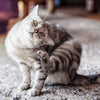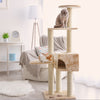Does Cat Litter Break Down?
- by Rufus and Coco
Are all types of cat litter biodegradable? Should you worry about scooping out your cat’s waste and putting it into a plastic bag? What are the worst and the best litters in terms of their environmental impact? We’re answering all of these questions and more in today’s article, so keep on reading!
Does cat litter break down?
Not all cat litters are created equal, and since they can be made from such a wide range of materials, they have different impacts on our environment. For example, clay litter is the worst you might want to get, especially if you throw it out in plastic bags.
What environmental impact does clay litter have on the planet? It’s not that difficult to tell how it affects the environment. On archeological sites, clay pots are found even today, so they will never break down even when placed in very fertile soil.
Crystal cat litter isn’t any better either. It’s not a sustainable or alternative option and it doesn’t break down.
The answer to the main question is that only litters clearly marketed as biodegradable are safe for the environment. For example, the Rufus & Coco Wee Kitty Clumping Corn Litter is entirely made from grain. It doesn’t contain any additives or chemicals, which is why it is also perfectly safe for cats.
Our Wee Kitty Eco Plant alternative is another great choice if you care about the environment and your feline mate’s health. This one is made from wheat and soy fibres, and it is entirely compostable. Believe it or not, you can even flush it down the toilet, which automatically minimises the amount of plastic waste you might produce when storing the clumps into bags and throwing them away. Also, since it's low dusting, it’s safe to use for cats with a history of respiratory problems.
You could also try our Do Good Cat Litter as it is made from both pea and corn fibres, all of which are biodegradable. It's cheaper than our Corn and Eco Plant variants, but is equally capable of trapping odours in a timely fashion, quick-clumping, and absorbs up to four times the amount of liquid than other options in the market.
Picking the right type of cat litter
Below are some factors you will want to consider when making a decision in choosing cat litter.
Eco-friendly and easy to dispose of
Clay litter and silica-based gel crystals are the worst choices in terms of their environmental impact. But litter can be manufactured from other materials, most of which can be disposed of by flushing small quantities in the toilet. Here are several examples:
-
Corn
-
Wheat
-
Pea fibres
-
Tofu
-
Cassava
-
Walnut
-
Coconut
-
Dust-free
Clay litter is the worst when it comes to how safe it is for cats. It produces a lot of dust, and if you’ve ever used such a product before, you probably know that it can stick to your pet’s paws, which can then be carried and scattered around in your home.
But that’s not the only problem that dust can cause. Some can release so much that your cat can ingest and inhale it, leading to serious respiratory health issues.
Furthermore, the dust from clay litter contains sodium bentonite, which some cats can ingest by grooming their bodies. This can lead to intestinal blockages caused by the substance combining with your cat’s digestive content and the hair she regularly swallows, especially in heavy shedding periods.
Corn, wheat, tofu, coconut husk, and recycled paper litter are the best options if you want a dust-free alternative.
Highly absorbent and clumping
The eco-friendly litter that you end up choosing has to absorb your cat’s liquid waste in such a way so as to minimise the amount of ammonia that exists in the litter box.
The clumping ability of some products will make it easier for you to scoop the solids and get rid of them, therefore eliminating the risk of your cat developing a urinary infection by closely coming in contact with her waste.
Safely switching your cat’s litter to an eco-friendly alternative
If you have been a cat parent for a while, you probably know that cats tend to have preferences and might not react well to sudden changes.
For this reason, we recommend adding small amounts of the new litter to the old until you gradually increase the quantity of the eco-friendly one and get your cat accustomed to using it.
Do consider that cats whose litter is changed suddenly might have accidents outside their litter box. If this occurs, even if you switch to the new one gradually, it could be a sign that your cat might be suffering from a condition -- especially since our feline friends aren’t that good at showing symptoms of disease in general.
- Posted in:
- cat
- cat litter
- litter
- weekitty








